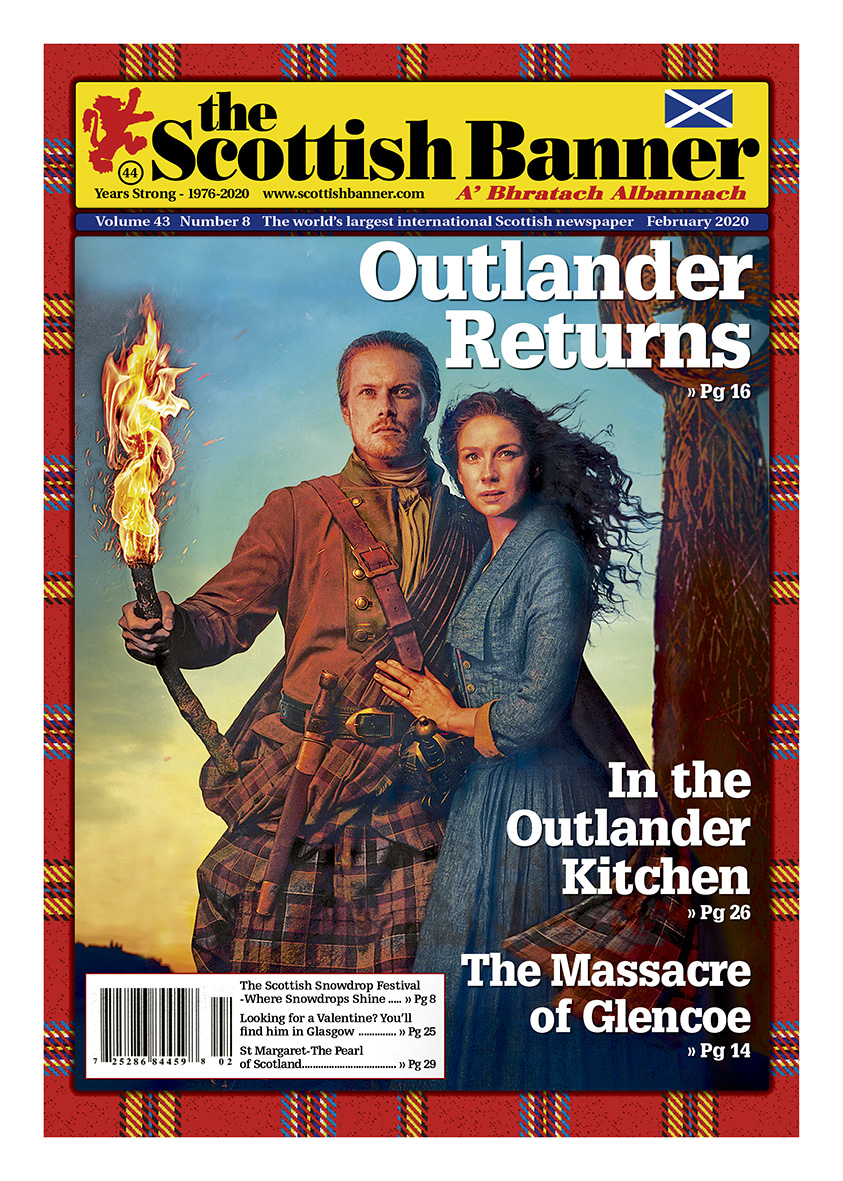February 2020 (Vol. 43, Number 08)
-

Outlander returns with Caitriona Balfe (Claire Fraser), Sam Heughan (Jamie Fraser). Photo courtesy of Starz.
The Banner Says…
Scotland’s leap of tradition
The month may be the shortest of the year, but this February does see an extra day as we are in a leap year. Leap Year Day, as it is known, will take place on Saturday February 29th. Just why do we have a
leap year you may wonder? Adding one additional day every four years keeps our calendar aligned correctly with the astronomical seasons. Our calendar year is defined as the time it takes for the Earth to orbit around the Sun once.
It takes the Earth about 365 days to do this, or more specifically, 365 ¼ days. Our normal calendar allows for just 365 days a year and without this extra day,
our calendar and the seasons would gradually get out of sync.
Leap Year Day tradition
In Scotland Leap Year Day has its very own unique traditions. February 29th is the day a woman could propose. The custom is believed to have originated in Ireland and came from a decree from the Scottish born Patron Saint of Ireland, Saint Patrick, and was brought over to Scotland by Irish monks. Apparently, St. Bridget complained to St. Patrick about women who had to wait too long for men to make proposals of marriage.
In 1288 the unmarried Queen Margaret of Scotland passed a law that allowed a woman to propose marriage (often wearing red) to their true love in a leap year, with the law also stating that any man who declined the proposal on this day would have to pay a fine.
Fines could include money, gloves or silk. Gloves were particularly popular as this was a way a woman could hide the embarrassment of not wearing an engagement/wedding ring.
Scottish farmers used to believe leap years are not good for crops or livestock, thanks to the old Scots proverb: “Leap year was ne’er a good sheep year.”
In Scotland, it also used to be considered unlucky for someone to be born on leap day, just as Friday 13th is considered an unlucky day by many. However, those Pisceans
born on February 29th have unique talents, including high levels of creativity and the ability to give sound advice.
In this issue
This month millions of people around the world will be leaping onto their couches as season five of the hit TV show Outlander hits our screens, bringing an end to ‘Droughtlander’. We have some great Outlander themed content in this issue.
And whether you are a fan of the show, the books or not at all (is that possible?), there is no denying what a huge cultural impact the series has had and continues to have on Scotland. The story of Scotland’s history is very on trend, for not just Scots but those who love history and drama. Scotland has that in spades and Outlander has done wonders for Scottish tourism and the film industry and awoken many Scots to learning more of their past story.
We are also fortunate to have a variety of Outlander themed recipes by Theresa Carle-Sanders, author of the Outlander Kitchen cookbooks feature in this edition.
One of the darkest moments of Scottish history took place over 300 years ago this month.
The Massacre of Glencoe took place on the 13th February 1692, as the Clan MacDonald of Glencoe were slaughtered while they slept by Captain Robert Campbell and his men.
This tragic event took place mone of the most beautiful and dramatic places in Scotland and the massacre still is imprinted in the Scottish psyche and story.
One of Scotland’s great women of history surly must be Saint Margaret. In 1070 Margaret became Queen having married King Malcolm III. It was Margaret who initiated a ferry
crossing on the Firth of Forth and boats sailed the “Queen’s Ferry” from the 11th century until the 1960’s (this was not needed when the Forth Road Bridge opened in 1964) and
where North and South Queensferry take their names from. The oldest surviving building in Edinburgh is St Margaret’s Chapel, located within Edinburgh Castle. It was built around 1130 by David I who dedicated it to his mother, who certainly had an impact on Scottish history.
Valentine’s Day
This month also see romantics come out the woodwork on Valentine’s Day on February 14th. This literally was the case for Mary Queen of Scots as the French poet Pierre de Bocosel de Châtelard hid under the Queen’s bed at Rossend Castle in Fife to proclaim his love for her. Mary was not won over at all and had him executed for treason.
A Scottish tradition on Valentine’s Day was for young unwed men and women to write their name on pieces of paper, place them in a bonnet and each draw one of them. If one name was read out three times, it meant a marriage would take place. If you do not want to get that deep into commitment however, there is also National Flirting Week, taking place the week of February 9th!
Whilst you may not be writing names on paper or dawning a red outfit and asking your love to marry you (or be one who gets asked) on February 29th, whatever you get up to this month, enjoy the ‘extra day’ of February as you won’t have one again until Thursday, February 29, 2024.
Do you enjoy Outlander? Do you have a leap year or Valentine’s related story?
Share your story with us by email, post, social media or at: www.scottishbanner.com/contact-us
